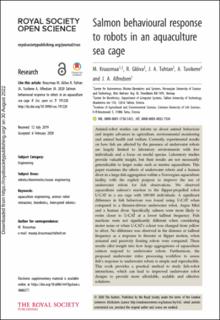| dc.contributor.author | Kruusmaa, Maarja | |
| dc.contributor.author | Gkliva, R. | |
| dc.contributor.author | Tuhtan, J.A. | |
| dc.contributor.author | Tuvikene, A. | |
| dc.contributor.author | Alfredsen, Jo Arve | |
| dc.date.accessioned | 2022-09-01T11:09:05Z | |
| dc.date.available | 2022-09-01T11:09:05Z | |
| dc.date.created | 2021-02-02T12:09:28Z | |
| dc.date.issued | 2020 | |
| dc.identifier.citation | Royal Society Open Science. 2020, 7 (3), . | en_US |
| dc.identifier.issn | 2054-5703 | |
| dc.identifier.uri | https://hdl.handle.net/11250/3015106 | |
| dc.description.abstract | Animal–robot studies can inform us about animal behaviour and inspire advances in agriculture, environmental monitoring and animal health and welfare. Currently, experimental results on how fish are affected by the presence of underwater robots are largely limited to laboratory environments with few individuals and a focus on model species. Laboratory studies provide valuable insight, but their results are not necessarily generalizable to larger scales such as marine aquaculture. This paper examines the effects of underwater robots and a human diver in a large fish aggregation within a Norwegian aquaculture facility, with the explicit purpose to improve the use of underwater robots for fish observations. We observed aquaculture salmon's reaction to the flipper-propelled robot U-CAT in a sea cage with 188 000 individuals. A significant difference in fish behaviour was found using U-CAT when compared to a thruster-driven underwater robot, Argus Mini and a human diver. Specifically, salmon were more likely to swim closer to U-CAT at a lower tailbeat frequency. Fish reactions were not significantly different when considering motor noise or when U-CAT's colour was changed from yellow to silver. No difference was observed in the distance or tailbeat frequency as a response to thruster or flipper motion, when actuated and passively floating robots were compared. These results offer insight into how large aggregations of aquaculture salmon respond to underwater robots. Furthermore, the proposed underwater video processing workflow to assess fish's response to underwater robots is simple and reproducible. This work provides a practical method to study fish–robot interactions, which can lead to improved underwater robot designs to provide more affordable, scalable and effective solutions. | en_US |
| dc.language.iso | eng | en_US |
| dc.publisher | The Royal Society | en_US |
| dc.rights | Navngivelse 4.0 Internasjonal | * |
| dc.rights.uri | http://creativecommons.org/licenses/by/4.0/deed.no | * |
| dc.title | Salmon behavioural response to robots in an aquaculture sea cage | en_US |
| dc.title.alternative | Salmon behavioural response to robots in an aquaculture sea cage | en_US |
| dc.type | Peer reviewed | en_US |
| dc.type | Journal article | en_US |
| dc.description.version | publishedVersion | en_US |
| dc.source.pagenumber | 14 | en_US |
| dc.source.volume | 7 | en_US |
| dc.source.journal | Royal Society Open Science | en_US |
| dc.source.issue | 3 | en_US |
| dc.identifier.doi | 10.1098/rsos.191220 | |
| dc.identifier.cristin | 1885819 | |
| dc.relation.project | Norges forskningsråd: 223254 | en_US |
| cristin.ispublished | true | |
| cristin.fulltext | original | |
| cristin.qualitycode | 1 | |

